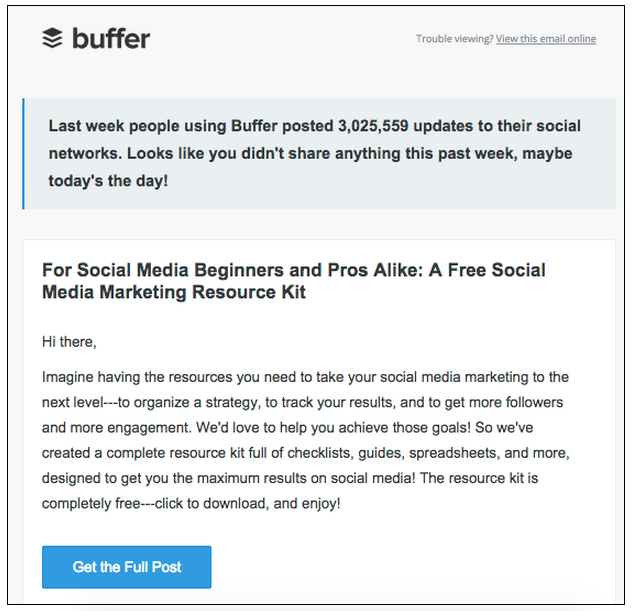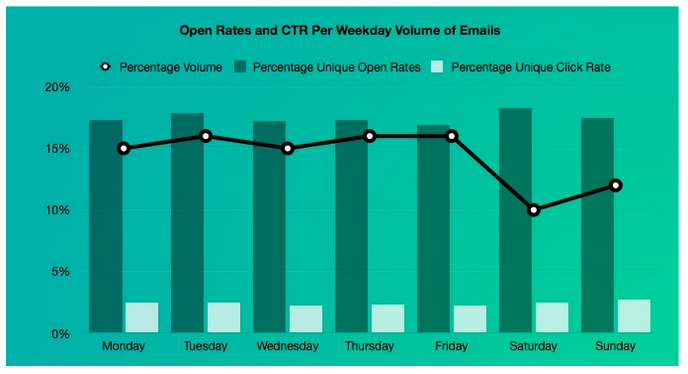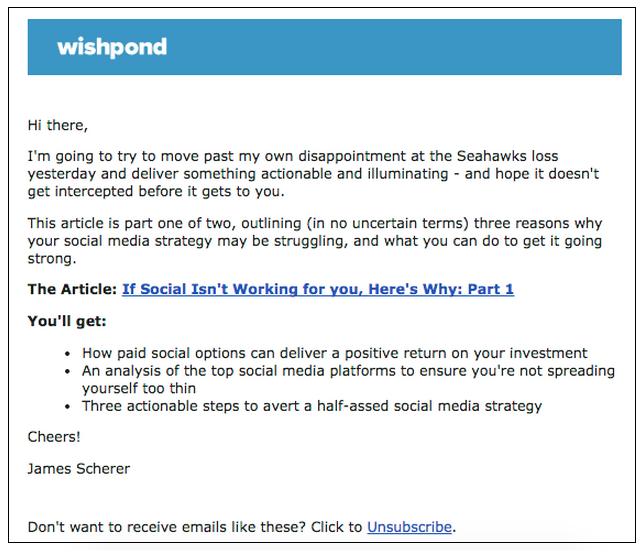It’s 12pm on a Monday and I’ve already (between my personal and work accounts) received 47 emails.
Now, let’s say, for fun, that I not only opened all of these emails but I also completed the action inside. If I was lucky, I’d be about half-way through at this point (had I started at 9am).
So it got me thinking, what makes a person open and click-through on an email they receive?
For me, it’s almost exclusively the person who has sent it – meaning you need to establish TRUST.
For my coworkers, it’s the tone, style and copy – meaning you need to craft engaging CONTENT.
For my friends, it’s time of day (they don’t check their emails as frequently as I do) – meaning you need to send it at the right TIME.
For my parents, if they can remember the password to their accounts they’re laughing…once they gain access they’re opening every email and inspecting them with a fine-toothed comb..[What’s a Gmail?] In other words N/A.
The thing is, it’s not just one thing that’s going to make your email marketing strategy successful, it’s really everything. Since your time is precious, I’ve narrowed down a few of the most likely reasons your email marketing efforts are falling short.
Let’s crack this lock together 🙂
1.) You haven’t created trust
The other night, one of my friends professed that I’m one of his favorite people to be around.
I probed, “why is that?” I thought the answer would be along the lines of, “because you’re super attractive and hilarious and humble”… but the answer surprised me. He said, “because I trust you.”
Now, I’m sure that he believes all of those other things about me (especially the humble part), but trust was his number one reason over all others.
And it’s pretty easy to create trust between friends: don’t talk about them behind their back, don’t tell their secrets, don’t post photos of them with their head in a toilet bowl on social media. Boom, easy.
But how do you create trust online? This is a bit trickier.
The trust bank
In order for someone to trust you there needs to be more credits in your business’ trust bank than debits. Anytime that you send someone information that is helpful (something that fulfills their needs) the trust will grow. Something like a free ebook that gives them tips on growing their business and doesn’t ask them for additional information (this part is key).
Once – and only once – you’ve given away enough credits can you start to debit from the trust bank. Debits happen when you focus on your own needs as a business and not on the people you’re sending an email to. This is company-centered information like pushy sales pitches and automated responses.
Creating trust with your email marketing strategy:
- Only send emails to people who want to receive them from you.
- Have a clearly marked and easy way to unsubscribe from your emails. I personally find it incredibly annoying when I have to re-enter my email when unsubscribing.
- Start by introducing yourself. Nothing makes me more skeptical than when I start receiving emails from a random company. Even if I’ve subscribed to their emails, a nice welcome is always appreciated. I’m giving a shoutout to Wistia here because I think they’re awesome and I love the email below, it made me feel so welcomed!

- Be relatable. I’m going to share one from Wishpond for this section because I love reading James’ emails. Even though I’m not personally a fan of sports in general, I can relate to the way he was feeling after the devastating blow that was the Super Bowl.

- Provide valuable content. Valuable content does not mean a sales pitch, or a free trial. It means giving people the tools they need to succeed, period. It shouldn’t be contingent of them using your tools in order to succeed.
Trust happens over time. You’re wooing people so that at one point they’ll stop caring what you send and just open no matter what.
2. You’re not thinking about the user-experience
Think about the most amazing email you’ve ever received. If one doesn’t come to you straight-away, I implore you go through some of the ones you’ve recently received but haven’t opened.
Did any of them pop out?
I can safely say that it’s been a while since I’ve been surprised by the content of an email. The thing is, although I’d love to open an email and be wowed, I also appreciate a simple design.
Here’s an example email of what I mean by simple design (image below this list)…
– They’ve included their recognizable logo at the top left corner.
– They’ve included a stat which contrasts against the rest of the email by using a light blue background color.
– They’ve changed the size of text based on the importance of it within the email.
– They’ve included a call-to-action that contrasts from the rest of the page.

But don’t think you need to employ a designer to make the most of your email marketing. Just make sure it stands out from your competitors.
I’ve started unsubscribing to marketing newsletters that send me emails with the generic looking Arial 11-point text and hyperlink at the bottom. C’mon people, put your back into it.
If you want to create your own images check out Canva, it’s free, easy to use and you’ll have the ability to create amazing images without a graphic designer.
3. You haven’t made the most of your images
Did you know that according to Google, 43% of users view their emails with the images off? I don’t think this should be a reason to send emails without a background image but rather a marketing opportunity to seize.
Here’s what I mean by this, (by the way full credit is going to Litmus for this awesome tip):
When you put an image into your email using HTML you’ll have the option of submitting your own ‘img alt text’.
The HTML you’d use to upload an image is as follows:![]()
Now, instead of simply writing what the image is in the alt text, use it as an opportunity to market to your customers that have images turned off.
This means if it’s a picture of your latest ebook you could say something funny like, “I’m an ebook.”
Or, “Have you checked out our latest posts on Twitter? They’re pretty rad”
This way, you’re making use of the spaces that would normally have images.
4. You’re not sending it at the right time
There are tons of stats surrounding the perfect time to send an email. The thing is, the more global your company is, the less relevance time has to your business.
Wordstream says, “send it during the day, when people are awake.” The thing is, if your company operates worldwide, your customer will always be awake.
They also said, “Avoid sending emails on weekends.” I don’t buy this, as I personally am way more likely to open an email on a weekend. People are taking their weekends to grow their business and their weekdays to work their asses off (with no time to check non work-related email).
I found the following graph that shows the open rates and click-through-rate for each day based on the volume of emails. As you can see, no matter which day you’re sending an email, your open rates only shift about 5%.

Source: Email Marketing Quarterly Benchmark Study Q4
5. You sound like a robot
With email marketing (well, with all forms of marketing) you need to figure out how to generate an emotional response.
This means having an interesting subject line, body copy and actionable calls-to-action (remember action is in the word).
Let’s say that I was sending you an email about my latest blog post. If I simply wrote: “New post: [title of article]” people will probably open up the email. But how would I get more people to open it?
A recent article posted to the Wishpond blog was: “If Social Isn’t Working for You, Here’s Why: Part 1 of 2” – I know, similar to the one I’m writing right now, (you should probably check it out ;). Here are 4 email subject lines I would test:
- “New Friend Request: Are you making these social mistakes?”
- “4 Ways You Can Get People to Engage with Your Content on Social”
- “Are you spreading yourself too thin on social?”
- “Stop half-assing your social”
I encourage you to hand write each email you send out. I find that a lot of the emails I receive around blog posts are just a verbatim introductory paragraph. Think of the person you’re sending this to as your friend. You’re not just going to copy and paste exactly what was said in the article. Why should they read it?
If I wanted one of my friends to read something it would go something like this…
Happy [Day of the week],
_I just wanted to give you a heads up that the newest article on [subject of the article] has just been posted! In it, we look at how [thing you’re talking about] to help you make actionable changes in your business. _
You can check out the article here: [link to article]
I know that [A] is important to you because you subscribed to my blog. I just want to make sure you’re on top of [the thing you do].
>By the way, do you have any amazing articles to share with me? Any insights on some of the posts I’ve been sharing with you? If you have some constructive criticism let me know (I can take it!) I want the posts I share with you to be as awesome as I think they are.
Cheers,
[Your name]
Finally, make sure you’re including a call-to-action on your email. If possible, include it in the form of a button.
If it’s a blog post say:
- “Read the newest article”
- “Get the hottest tips now”
- “Download the latest post”
- “Start learning about [X] now”
It’s a good idea to play around with different formats to see what resonates most with your audience.
Related Content
- 70 Essential Email Marketing Terms You Should Know
- 19 Free Email Marketing Templates to Nurture, Sell, Onboard and Reach Out
- 9 Email Marketing Best Practices
- 15 Types of Marketing Emails You Need to be Sending
- 12 Best Email Marketing Tips for Entrepreneurs
Conclusion
I’m super curious to know how many of your emails you take action on. Is it a percentage? Does it change from week-to-week, day-to-day? Do you always open emails from so-and-so but never from this-and-that?
Let me know in the comment section below!
– Written by Samantha Mykyte
When Samantha isn’t crushing content at Wishpond she performs with her burlesque troupe, casts spells in dungeons and dragons and enjoys hitting the slopes.



